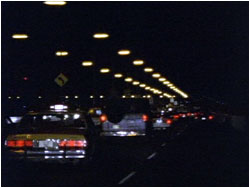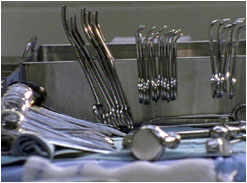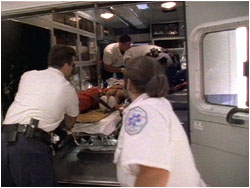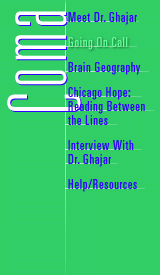The Journey Begins | Dear Film Crew: Help! | On Call | Alex's Case
Saturday, August 24, 1996
The "Medical Tower" Apartments next to New York Hospital
Room 1021
At 6:00 a.m. this past Thursday, Dr. Ghajar began a period on call. And so
did the NOVA COMA crew. Team 1 members are posted at Jamaica; Team 2
members are here at New York Hospital.
Around 10:00 p.m., Team 1 gets beeped. After 10 minutes, as rehearsed, they
call me on the cell phone code. It looks like a real case of head trauma.
 The patient was in a motorcycle accident. The crew has used two rolls of
film already and is eager to continue filming. But it's my job to play the
role of dispassionate observer. I need to ask some cool-headed questions:
Was the patient wearing a helmet? The crew had not yet gotten that
information and proceeds to investigate. The answer comes back: yes. Was
the helmet scratched or dented. Were there any signs on the helmet that
might lead you to believe this patient received a severe head trauma?
Again, the team goes back to investigate. The answer: no. I ask the
team to stand by, rather than rolling more film. This doesn't sound like
severe head trauma to me at all—it sounds like the patient might be
unconscious due to a pre-existing seizure condition, or something.
Initially, the crew is frustrated with me, certain that we're going to
miss critical steps of a real case; but ten minutes later, the police and
medical personnel piece together this story: There was no accident. The
patient does indeed have a pre-existing seizure condition and had pulled
over his bike, and was found, lying next to it, unconscious. This is a
false start.
The patient was in a motorcycle accident. The crew has used two rolls of
film already and is eager to continue filming. But it's my job to play the
role of dispassionate observer. I need to ask some cool-headed questions:
Was the patient wearing a helmet? The crew had not yet gotten that
information and proceeds to investigate. The answer comes back: yes. Was
the helmet scratched or dented. Were there any signs on the helmet that
might lead you to believe this patient received a severe head trauma?
Again, the team goes back to investigate. The answer: no. I ask the
team to stand by, rather than rolling more film. This doesn't sound like
severe head trauma to me at all—it sounds like the patient might be
unconscious due to a pre-existing seizure condition, or something.
Initially, the crew is frustrated with me, certain that we're going to
miss critical steps of a real case; but ten minutes later, the police and
medical personnel piece together this story: There was no accident. The
patient does indeed have a pre-existing seizure condition and had pulled
over his bike, and was found, lying next to it, unconscious. This is a
false start.
For a moment I feel like Oliver Sacks, having made the right call.
Meanwhile, the film crew at Jamaica is frustrated. How are they supposed
to ask these sorts of questions in the heat of battle—when a case is
unfolding? The trauma team is focusing on basic resuscitation—the ABCs,
for airway, breathing and circulation. They don't have time to answer crew
questions about helmets and so on.
The experience suggests that the split crews may be a mistake—that it's
asking too much of a two-person crew to film and make medical assessments
at the same time. But we all decide to give it one more day in the current
arrangement.
Sunday, August 25, 1996
Team 2 post, Helmsley Medical Tower Apartments
(next door to New York
Hospital)
Just 24 hours ago, both teams were rolling on minor concussions, or cases
that involved no head trauma. And we didn't know what questions to ask.
Now, we're bandying about terms such as p.l.o.c., for positive loss of
consciousness, epidural hematoma, and "intubated at scene." [See Chicago
Hope: Reading Between the Lines.]
With each false start, we learn something useful about what might happen
when we begin documenting a real head trauma case. We're all much more
confident about keeping the teams split and about our ability to respond to
such a case.
Friday, August 30, 1996
Team 2 post, New York Hospital
But no severe head trauma cases come—to New York or Jamaica
Hospital—despite the fact that we've been on call for eight days.
Life "on call" has had a number of mind-bending factors. First, there are
no regular rhythms to the day. Just as you start to relax around 6:00 or
7:00 p.m., the usual end to a workday, just as you start to forget the
24-hour nature of this gig, the beepers go off! (Between our two
 locations, we have been beeped and have raced to the emergency rooms about
16 times for false starts.) The only consistently quiet time thus far is
between about 4:00 a.m. and 10:00 a.m.
locations, we have been beeped and have raced to the emergency rooms about
16 times for false starts.) The only consistently quiet time thus far is
between about 4:00 a.m. and 10:00 a.m.
Second, there is the confinement. We are all tethered to an emergency
room, beyond which we cannot stray further than three minutes, the time
between when beepers will first alert us, and when the ambulance pulls in.
As a measure of how psychologically odd the confinement is making all of
us, we quiz Peter, the sound person, about a recent dental appointment. He
replaced himself with another sound person to cover his post for an
emergency office visit. And we all want to hear, in real time, what it was
like to "go out." A dental appointment is now a coveted activity.
At the post for Team B, Jeffrey, the assistant camera person, and I simply
have not gotten the knack of having someone else supply us with all the
groceries we need. Specifically, we have, for the last eight days,
repeatedly forgotten to have the production assistant buy us salt. Today,
we convert a piece of NOVA stationary into a make-shift sieve, by punching
holes, and up-end a bag of pretzels, sifting for the desired seasoning.
I had imagined that after the first couple of days on call, after we
perfectly set up our posts, we could retire to our living quarters to read
great books in between the beepers going off. But there's an endless
stream of adjustments in the logistics of this shoot. And even when there
are apparent "down" moments, it's hard to concentrate on a book or
movie—or to sleep—when you know that the beeper can go off at any second.
After days of this, I turn to Dr. Ghajar in exasperation: How do you do
this? Is this really how you live?
Early on in his career, he confessed, it was very difficult for him to do
any other activity. When he swam, he would have to check to see if his
pager had gone off at the end of every lap. And even now, when he's on
call, he still avoids leaving his neighborhood on the East Side, which is
better positioned for darting over to Jamaica Hospital than, say, mid-town.
But even more psychologically difficult on this project than the
confinement is the dreadful reality that the very event we are waiting to
document will be the worst moment in someone else's life. We are poised
and ready and rehearsed—for some family's worst nightmare. The longer we
wait, the harder it is to face this aspect of the project.
I am honestly beginning to think that this idea is a mistake. Team members
encourage me to wait until after the Labor Day weekend. They are confident
that we will begin documenting a case then—and that this will bring back
the sense of purpose I had when the project began.
Tuesday, September 3, 1996
A pedestrian walkway that hangs over FDR Drive—
and provides good views of the East River,
three minutes run from New York Hospital
Jeffrey, my team partner at New York Hospital, loaded himself up with his
camera equipment one day and set out to find us a spot to sit outdoors,
 which would still be within three minutes of the emergency room. On an exit
road to FDR Drive, which winds along the East River, he discovered a
pedestrian overpass. From this vantage, we can get some fresh air and
watch the strange tug boats that go up and down the river everyday. Also
from this spot, if we're beeped, we can race right through an open parking
garage to the e.r. within the three-minute safety period.
which would still be within three minutes of the emergency room. On an exit
road to FDR Drive, which winds along the East River, he discovered a
pedestrian overpass. From this vantage, we can get some fresh air and
watch the strange tug boats that go up and down the river everyday. Also
from this spot, if we're beeped, we can race right through an open parking
garage to the e.r. within the three-minute safety period.
When the walls of our post are closing in, Jeffrey and I suit up with our
camera and sound equipment and take to this perch. This is where I begin
the day, after the holiday weekend.
I'm bracing for a talk with the home office. I pretty much led them to
believe that we could count on Labor Day weekend for a more active
emergency room. But it turned out to be the quietest weekend on record at
both hospitals! We still have no case. Now we have to decide whether to
stop the project or go forward. I find myself concocting superstitious
games—such as, if the next tug boat that passes by has blue lettering on
it, we'll stop the project. This sort of thing.
Jeffrey agrees to take the equipment to the e.r. and stand watch, so that I
can walk just one more block away to Dr. Ghajar's office. It's slightly
out of the three-minute range to New York Hospital, but I need his advice.
(This is how Jeffrey and I have conducted business over the last nine
days, dragging equipment back and forth, one person standing watch, while
the other takes a risk and ventures just one or two minutes further than
the outer boundary of the quick-response zone. I admit, one day, we broke
down and ventured beyond the quick zone to buy salt.)
Dr. Ghajar's mission is in part for the public to recognize that it doesn't
take a miracle for patients to come out of a coma and do well—it takes the
application of good science. I need this sort of rational thinking at
this point.
"You look really depressed," Dr. Ghajar says when I walk into his office.
I'm about to earn the dubious distinction of being the first producer in
NOVA history to walk away from a 10-day shoot with absolutely no film in
the can. I think I have good reason to look depressed.
I explain to Dr. Ghajar that it's time to make a critical decision. If I
don't want to assume any further financial risk, I can advise that we cut
our losses and bail out of the project. Or, I can lead my bosses further
down this risky path, knowing that we could wait another two weeks, and
come out empty-handed. The next time Dr. Ghajar goes on call is September
20th, at summer's end, when cases of severe head trauma are expected to
dwindle anyway.
But Dr. Ghajar suggests that I consider the "reversion to the mean." He
usually averages one to two cases of severe head trauma a week, and the
past month has been unusually slow. But sooner or later, the law of
averages will kick in, he says.
Then, I feel guilty again that we're waiting for something that will be one
of the most terrible events in the life of some as yet unknown family.
Dr. Ghajar reminds me that our waiting to document a case doesn't make
the case happen.
I return to the FDR overpass and watch the tug boats. I think of all the
fantastic team members on this project. I think of Peter, the primary
sound person, trying to boil pasta with a hot plate over a bathroom sink at
Jamaica Hospital, night after night, never complaining. I think of how he
and Dyanna Taylor (who filled in for camera person Tom Hurwitz in the
critical first few days) devised a "quick-response cart" to help get the
crew's equipment from the trauma room to the CT scan and back again, after
the first couple of false starts. I think of how cool-headed Tom has
remained in the face of some horrific false-start cases—multiple
gun-shot wounds, injured infants where abuse is suspected—that sort of
thing.
I think of Jeffrey, the assistant camera person, having set up our Team 2
post at New York Hospital and how every morning he goes to the e.r. to
change the film loaded in the camera from nighttime to daytime stock, and
then back again when it gets dark. We will have the job of filming Dr.
Ghajar in his car en route to Jamaica if a case starts there. If we need
to film the drive in the daylight, that requires one sort of stock; in the
nighttime, it will require another sort of stock. So Jeffrey has to keep
downloading and reloading the film in the camera, depending on what time of
day it is!
Everyone has scouted, produced and directed their own posts. They've
learned, on their own, when to roll and not to roll film, and what needs to
 be done in between to remain prepared. They talk about cases now as if
they've been to med school. It's so affirming how committed they are to
the project.
be done in between to remain prepared. They talk about cases now as if
they've been to med school. It's so affirming how committed they are to
the project.
On top of that, two hospital administrations, dozens of paramedics, dozens
of trauma team members, and Dr. Ghajar—all had said, okay, you can come
along on this emotional journey. We might be able to witness, alongside a
family, a loved one emerge from a deep state of unconsciousness, after days
or weeks in a coma. We might be able to witness first-hand the treatments
that Ghajar and colleagues are trying to establish as standards in their
field. We might be able to discover why many hospitals have not adopted
these standards, despite the building scientific evidence to support them.
What if we do document a case, and it helps to bring the problem of head
trauma—the number one cause of death and disability in the age group one
to 44—to the public's attention? What if our audience comes to realize
that outcome in such cases is shaped not only by severity of injury, but
also by where the accident happens? What if this, in some small way, helps
to change practice?
I don't want to miss this journey. I leave the tug boat perch to go back to
my post and call the home office. I will recommend that we stay the course
and go back "on call" again.
The Journey Begins | Dear Film Crew: Help! | On Call | Alex's Case
Photos: (1-4) NOVA/WGBH Educational Foundation.

 The patient was in a motorcycle accident. The crew has used two rolls of
film already and is eager to continue filming. But it's my job to play the
role of dispassionate observer. I need to ask some cool-headed questions:
Was the patient wearing a helmet? The crew had not yet gotten that
information and proceeds to investigate. The answer comes back: yes. Was
the helmet scratched or dented. Were there any signs on the helmet that
might lead you to believe this patient received a severe head trauma?
Again, the team goes back to investigate. The answer: no. I ask the
team to stand by, rather than rolling more film. This doesn't sound like
severe head trauma to me at all—it sounds like the patient might be
unconscious due to a pre-existing seizure condition, or something.
Initially, the crew is frustrated with me, certain that we're going to
miss critical steps of a real case; but ten minutes later, the police and
medical personnel piece together this story: There was no accident. The
patient does indeed have a pre-existing seizure condition and had pulled
over his bike, and was found, lying next to it, unconscious. This is a
false start.
The patient was in a motorcycle accident. The crew has used two rolls of
film already and is eager to continue filming. But it's my job to play the
role of dispassionate observer. I need to ask some cool-headed questions:
Was the patient wearing a helmet? The crew had not yet gotten that
information and proceeds to investigate. The answer comes back: yes. Was
the helmet scratched or dented. Were there any signs on the helmet that
might lead you to believe this patient received a severe head trauma?
Again, the team goes back to investigate. The answer: no. I ask the
team to stand by, rather than rolling more film. This doesn't sound like
severe head trauma to me at all—it sounds like the patient might be
unconscious due to a pre-existing seizure condition, or something.
Initially, the crew is frustrated with me, certain that we're going to
miss critical steps of a real case; but ten minutes later, the police and
medical personnel piece together this story: There was no accident. The
patient does indeed have a pre-existing seizure condition and had pulled
over his bike, and was found, lying next to it, unconscious. This is a
false start.
 locations, we have been beeped and have raced to the emergency rooms about
16 times for false starts.) The only consistently quiet time thus far is
between about 4:00 a.m. and 10:00 a.m.
locations, we have been beeped and have raced to the emergency rooms about
16 times for false starts.) The only consistently quiet time thus far is
between about 4:00 a.m. and 10:00 a.m.
 which would still be within three minutes of the emergency room. On an exit
road to FDR Drive, which winds along the East River, he discovered a
pedestrian overpass. From this vantage, we can get some fresh air and
watch the strange tug boats that go up and down the river everyday. Also
from this spot, if we're beeped, we can race right through an open parking
garage to the e.r. within the three-minute safety period.
which would still be within three minutes of the emergency room. On an exit
road to FDR Drive, which winds along the East River, he discovered a
pedestrian overpass. From this vantage, we can get some fresh air and
watch the strange tug boats that go up and down the river everyday. Also
from this spot, if we're beeped, we can race right through an open parking
garage to the e.r. within the three-minute safety period.
 be done in between to remain prepared. They talk about cases now as if
they've been to med school. It's so affirming how committed they are to
the project.
be done in between to remain prepared. They talk about cases now as if
they've been to med school. It's so affirming how committed they are to
the project.